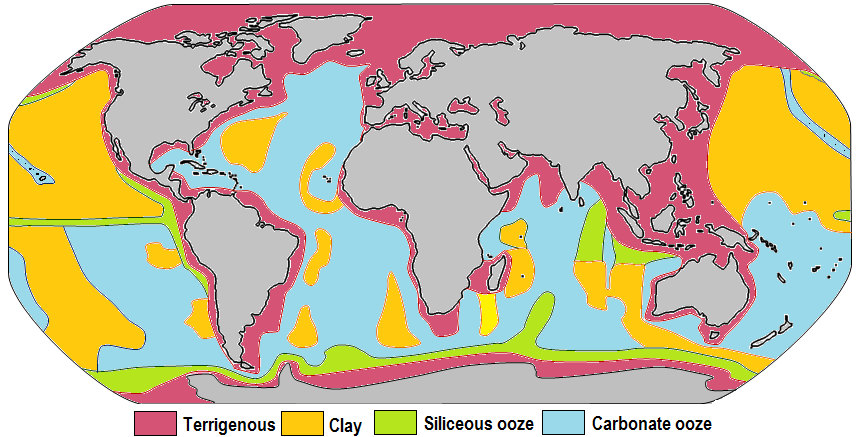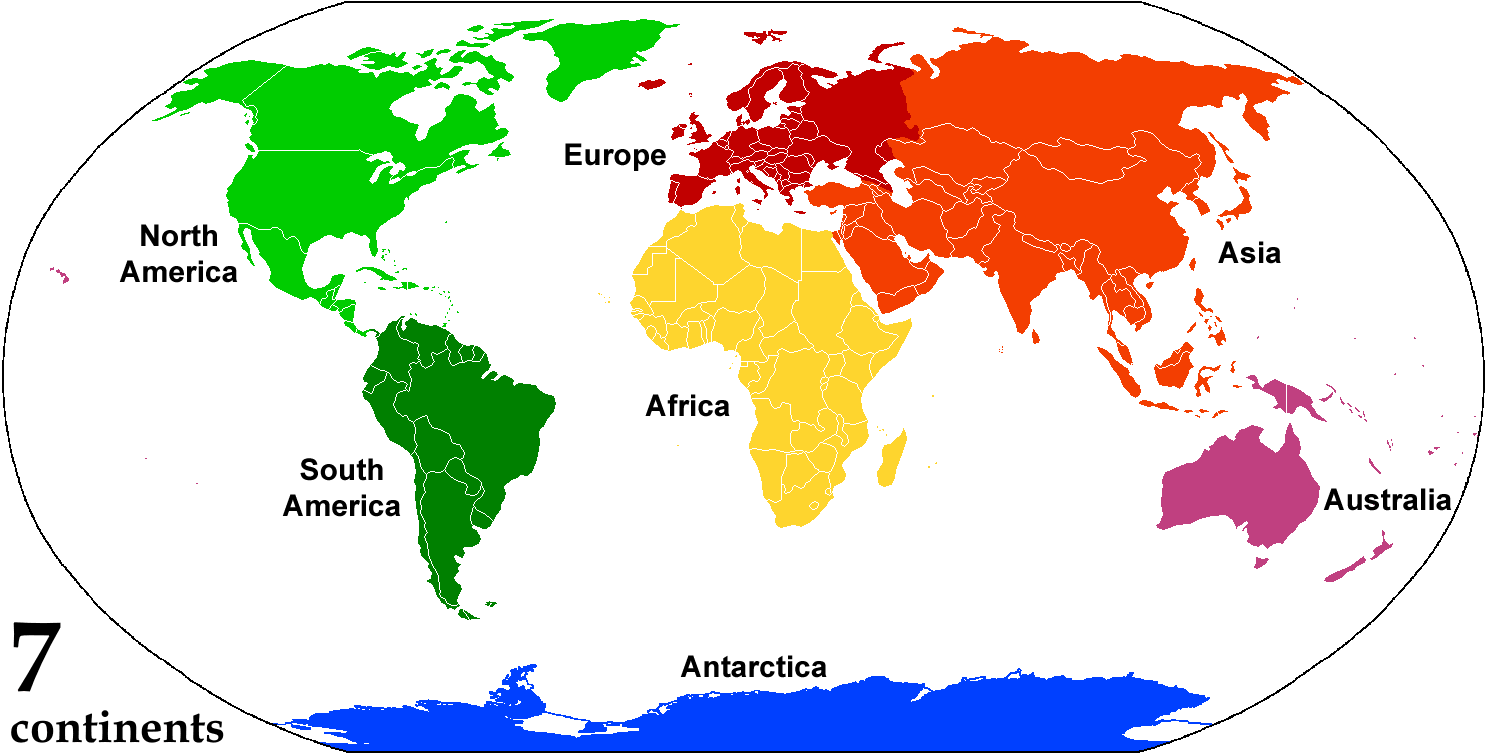|
Biogenous Ooze
Biogenous ooze is a type of marine sediment composed of a high percentage of organic compounds. Composition Biogenous ooze consists of organic compounds, usually in the form of microorganism tests that fall from closer to the ocean surface to the ocean floor after death. For marine sediment to receive this classification, it must be composed of more than 30% skeletal material. The two primary types of ooze are siliceous, which is composed primarily of silica (SiO2), and calcareous or carbonate, which is mostly calcium carbonate (CaCO3). In an area in which biogenous is the dominant sediment type, the composition of microorganisms in that location determines to which category it is classified. The primary types of microorganisms used to classify ooze are radiolarians and diatoms (siliceous) and coccolithophores and foraminifera (calcareous). The presence of these organisms can lead to sub-classifications based upon their dominance. Distribution Despite the common associa ... [...More Info...] [...Related Items...] OR: [Wikipedia] [Google] [Baidu] |
Marine Sediment
Marine sediment, or ocean sediment, or seafloor sediment, are deposits of insoluble particles that have accumulated on the seafloor. These particles have their origins in soil and rocks and have been transported from the land to the sea, mainly by rivers but also by dust carried by wind and by the flow of glaciers into the sea. Additional deposits come from marine organisms and chemical precipitation in seawater, as well as from underwater volcanoes and meteorite debris. Except within a few kilometres of a mid-ocean ridge, where the volcanic rock is still relatively young, most parts of the seafloor are covered in sediment. This material comes from several different sources and is highly variable in composition. Seafloor sediment can range in thickness from a few millimetres to several tens of kilometres. Near the surface seafloor sediment remains unconsolidated, but at depths of hundreds to thousands of metres the sediment becomes lithified (turned to rock). Rates of sedi ... [...More Info...] [...Related Items...] OR: [Wikipedia] [Google] [Baidu] |
Continental Shelf
A continental shelf is a portion of a continent that is submerged under an area of relatively shallow water, known as a shelf sea. Much of these shelves were exposed by drops in sea level during glacial periods. The shelf surrounding an island is known as an ''insular shelf''. The continental margin, between the continental shelf and the abyssal plain, comprises a steep continental slope, surrounded by the flatter continental rise, in which sediment from the continent above cascades down the slope and accumulates as a pile of sediment at the base of the slope. Extending as far as 500 km (310 mi) from the slope, it consists of thick sediments deposited by turbidity currents from the shelf and slope. The continental rise's gradient is intermediate between the gradients of the slope and the shelf. Under the United Nations Convention on the Law of the Sea, the name continental shelf was given a legal definition as the stretch of the seabed adjacent to the sh ... [...More Info...] [...Related Items...] OR: [Wikipedia] [Google] [Baidu] |
Deposition (geology)
Deposition is the geological process in which sediments, soil and rocks are added to a landform or landmass. Wind, ice, water, and gravity transport previously weathered surface material, which, at the loss of enough kinetic energy in the fluid, is deposited, building up layers of sediment. Deposition occurs when the forces responsible for sediment transportation are no longer sufficient to overcome the forces of gravity and friction, creating a resistance to motion; this is known as the null-point hypothesis. Deposition can also refer to the buildup of sediment from organically derived matter or chemical processes. For example, chalk is made up partly of the microscopic calcium carbonate skeletons of marine plankton, the deposition of which has induced chemical processes (diagenesis) to deposit further calcium carbonate. Similarly, the formation of coal begins with the deposition of organic material, mainly from plants, in anaerobic conditions. Null-point hypothesis The n ... [...More Info...] [...Related Items...] OR: [Wikipedia] [Google] [Baidu] |
Temperature
Temperature is a physical quantity that expresses quantitatively the perceptions of hotness and coldness. Temperature is measured with a thermometer. Thermometers are calibrated in various temperature scales that historically have relied on various reference points and thermometric substances for definition. The most common scales are the Celsius scale with the unit symbol °C (formerly called ''centigrade''), the Fahrenheit scale (°F), and the Kelvin scale (K), the latter being used predominantly for scientific purposes. The kelvin is one of the seven base units in the International System of Units (SI). Absolute zero, i.e., zero kelvin or −273.15 °C, is the lowest point in the thermodynamic temperature scale. Experimentally, it can be approached very closely but not actually reached, as recognized in the third law of thermodynamics. It would be impossible to extract energy as heat from a body at that temperature. Temperature is important in all fields of na ... [...More Info...] [...Related Items...] OR: [Wikipedia] [Google] [Baidu] |
Carbonate Compensation Depth
Carbonate compensation depth (CCD) is the depth in the oceans below which the rate of supply of calcite ( calcium carbonate) lags behind the rate of solvation, such that no calcite is preserved. Shells of animals therefore dissolve and carbonate particles may not accumulate in the sediments on the sea floor below this depth. Aragonite compensation depth (hence ACD) describes the same behaviour in reference to aragonitic carbonates. Aragonite is more soluble than calcite, so the aragonite compensation depth is generally shallower than the calcite compensation depth. Overview As shown in the diagram, biogenic calcium carbonate (CaCO3) tests are produced in the photic zone of the oceans (green circles). Upon death, those tests escaping dissolution near the surface, settle along with clays materials. In seawater, a dissolution boundary is formed as a result of temperature, pressure, and depth, and is known as the ''saturation horizon''. Above the saturation horizon, waters are ... [...More Info...] [...Related Items...] OR: [Wikipedia] [Google] [Baidu] |
Abyssal Zone
The abyssal zone or abyssopelagic zone is a layer of the pelagic zone of the ocean. "Abyss" derives from the Greek word , meaning bottomless. At depths of , this zone remains in perpetual darkness. It covers 83% of the total area of the ocean and 60% of Earth's surface. The abyssal zone has temperatures around through the large majority of its mass. Due to there being no light, there are no plants producing oxygen, which instead primarily comes from ice that had melted long ago from the polar regions. The water along the seafloor of this zone is actually devoid of oxygen, resulting in a death trap for organisms unable to quickly return to the oxygen-enriched water above. This region also contains a much higher concentration of nutrient salts, like nitrogen, phosphorus, and silica, due to the large amount of dead organic material that drifts down from the above ocean zones and decomposes. The water pressure can reach up to 76 megapascal. The area below the abyssal zone is the sp ... [...More Info...] [...Related Items...] OR: [Wikipedia] [Google] [Baidu] |
Deep Sea
The deep sea is broadly defined as the ocean depth where light begins to fade, at an approximate depth of 200 metres (656 feet) or the point of transition from continental shelves to continental slopes. Conditions within the deep sea are a combination of low temperatures, darkness and high pressure The deep sea is considered the least explored Earth biome, with the extreme conditions making the environment difficult to access and explore. Organisms living within the deep sea have a variety of adaptations to survive in these conditions. Organisms can survive in the deep sea through a number of feeding methods including scavenging, predation and filtration, with a number of organisms surviving by feeding on marine snow. Marine snow is organic material that has fallen from upper waters into the deep sea. In 1960, the bathyscaphe '' Trieste'' descended to the bottom of the Mariana Trench near Guam, at , the deepest known spot in any ocean. If Mount Everest () were submerged there, ... [...More Info...] [...Related Items...] OR: [Wikipedia] [Google] [Baidu] |
Deposition (chemistry)
In chemistry, deposition occurs when molecules settle out of a solution. Deposition can be viewed as a reverse process to dissolution or particle re-entrainment. See also * Atomic layer deposition * Chemical vapor deposition Chemical vapor deposition (CVD) is a vacuum deposition method used to produce high quality, and high-performance, solid materials. The process is often used in the semiconductor industry to produce thin films. In typical CVD, the wafer (substra ... * Deposition (physics) * Fouling * Physical vapor deposition * Thin-film deposition * Fused filament fabrication Chemical processes Physical chemistry {{Chem-stub ... [...More Info...] [...Related Items...] OR: [Wikipedia] [Google] [Baidu] |
Nutrient
A nutrient is a substance used by an organism to survive, grow, and reproduce. The requirement for dietary nutrient intake applies to animals, plants, fungi, and protists. Nutrients can be incorporated into cells for metabolic purposes or excreted by cells to create non-cellular structures, such as hair, scales, feathers, or exoskeletons. Some nutrients can be metabolically converted to smaller molecules in the process of releasing energy, such as for carbohydrates, lipids, proteins, and fermentation products (ethanol or vinegar), leading to end-products of water and carbon dioxide. All organisms require water. Essential nutrients for animals are the energy sources, some of the amino acids that are combined to create proteins, a subset of fatty acids, vitamins and certain minerals. Plants require more diverse minerals absorbed through roots, plus carbon dioxide and oxygen absorbed through leaves. Fungi live on dead or living organic matter and meet nutrient needs from thei ... [...More Info...] [...Related Items...] OR: [Wikipedia] [Google] [Baidu] |
Terrigenous Sediment
In oceanography, terrigenous sediments are those derived from the erosion of rocks on land; that is, they are derived from ''terrestrial'' (as opposed to marine) environments. Consisting of sand, mud, and silt carried to sea by rivers, their composition is usually related to their source rocks; deposition of these sediments is largely limited to the continental shelf. Sources of terrigenous sediments include volcanoes, weathering of rocks, wind-blown dust, grinding by glaciers, and sediment carried by rivers or icebergs. Terrigenous sediments are responsible for a significant amount of the salt in today's oceans. Over time rivers continue to carry minerals to the ocean but when water evaporates, it leaves the minerals behind. Since chlorine and sodium are not consumed by biological processes, these two elements constitute the greatest portion of dissolved minerals. Quantity Some 1.35 billion tons, or 8% of global river-borne sediment (16.5-17 billion tons globally), is tra ... [...More Info...] [...Related Items...] OR: [Wikipedia] [Google] [Baidu] |
Continent
A continent is any of several large landmasses. Generally identified by convention rather than any strict criteria, up to seven geographical regions are commonly regarded as continents. Ordered from largest in area to smallest, these seven regions are: Asia, Africa, North America, South America, Antarctica, Europe, and Australia. "Most people recognize seven continents—Asia, Africa, North America, South America, Antarctica, Europe, and Australia, from largest to smallest—although sometimes Asia and Europe are considered a single continent, Eurasia." Variations with fewer continents may merge some of these, for example America, Eurasia, or Afro-Eurasia are sometimes treated as single continents, which can bring the total number as low as four. Zealandia, a largely submerged mass of continental crust, has also been described as a continent. Oceanic islands are frequently grouped with a nearby continent to divide all the world's land into geographical regions. Unde ... [...More Info...] [...Related Items...] OR: [Wikipedia] [Google] [Baidu] |





